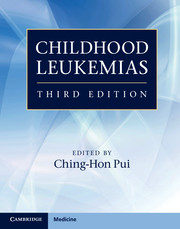Book contents
- Frontmatter
- Contents
- List of contributors
- Preface
- Section 1 History and general issues
- Section 2 Cell biology and pathobiology
- 4 Immunophenotyping
- 5 Immunoglobulin and T-cell receptor gene rearrangements
- 6 Cytogenetics of acute leukemias
- 7 Molecular genetics of acute lymphoblastic leukemia
- 8 Molecular genetics of acute myeloid leukemia
- 9 Epigenetics of leukemia
- 10 Genetics and cellular drug resistance in acute leukemia
- 11 Heritable predisposition to childhood hematologic malignancies
- Section 3 Evaluation and treatment
- Section 4 Complications and supportive care
- Index
- Plate Section
- References
6 - Cytogenetics of acute leukemias
from Section 2 - Cell biology and pathobiology
Published online by Cambridge University Press: 05 April 2013
- Frontmatter
- Contents
- List of contributors
- Preface
- Section 1 History and general issues
- Section 2 Cell biology and pathobiology
- 4 Immunophenotyping
- 5 Immunoglobulin and T-cell receptor gene rearrangements
- 6 Cytogenetics of acute leukemias
- 7 Molecular genetics of acute lymphoblastic leukemia
- 8 Molecular genetics of acute myeloid leukemia
- 9 Epigenetics of leukemia
- 10 Genetics and cellular drug resistance in acute leukemia
- 11 Heritable predisposition to childhood hematologic malignancies
- Section 3 Evaluation and treatment
- Section 4 Complications and supportive care
- Index
- Plate Section
- References
Summary
Introduction
Acute leukemia is best managed through the use of risk-adapted therapy. The karyotype of patients at diagnosis is an important factor in predicting response to therapy, and cytogenetic methods to detect the presence or absence of particular chromosomal abnormalities are key to stratifying patients by risk group. Identifying the genes involved in recurrent chromosomal abnormalities and understanding the roles of these genes in regulating cell growth and inducing malignant transformation can provide important insights into the altered biology of leukemic cells and help in devising novel risk-directed treatment strategies. This chapter reviews cytogenetic nomenclature and procedures as well as numeric and structural chromosomal abnormalities and their clinical associations, including prognosis, in acute lymphoblastic leukemia (ALL) and acute myeloid leukemia (AML). Associations between specific cytogenetic and molecular changes, and their roles in diagnosis and risk assessment are also discussed.
Conventional cytogenetics
Standard chromosomal analysis remains the method of choice for initial screening of karyotypic abnormalities in leukemic cells. Conventional cytogenetic methods detect chromosomal abnormalities in clones of mitotically active (metaphase) neoplastic cells only and are particularly efficient in identifying abnormalities associated with acute leukemias. These methods can detect an abnormal clone in 90% of children and adolescents with ALL and 80% of those with AML. They also permit the study of complex cytogenetic changes in neoplastic cells, although complementary genetic methods such as reverse transcriptase polymerase chain reaction (RT-PCR) or fluorescence in situ hybridization (FISH) are needed to detect cryptic abnormalities or to evaluate equivocal results.
- Type
- Chapter
- Information
- Childhood Leukemias , pp. 135 - 167Publisher: Cambridge University PressPrint publication year: 2012



